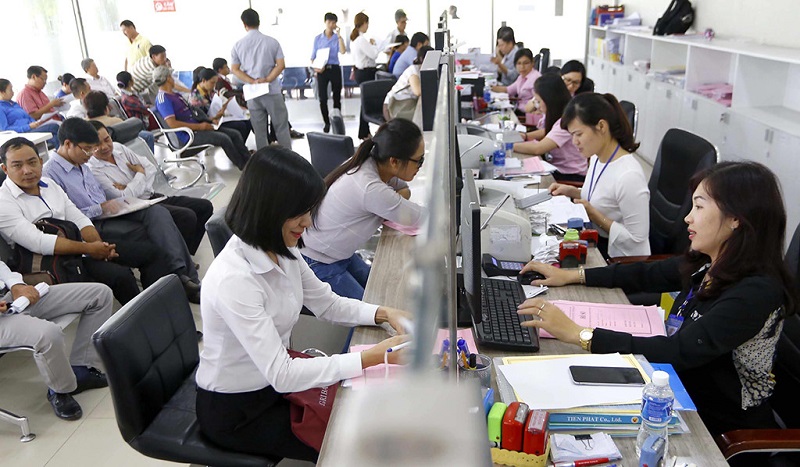Newest procedures for appointment of managerial public employees in Vietnam
Below are the newest procedures for appointment of managerial public employees in Vietnam under Decree 115/2020/ND-CP.

Newest procedures for appointment of managerial public employees in Vietnam (Image from the Internet)
1. Newest procedures for appointment of managerial public employees in Vietnam
The procedures for appointing managerial public employees according to Article 46 Decree 115/2020/ND-CP (amended at Clause 25, Article 1 Decree 85/2023/ND-CP) are as follows:
* Request for appointment
- The agency or unit requiring the appointment of a managerial public employee shall submit to the competent appointing authority a written request, clearly stating the position, title to be filled, the projected personnel source, and proposed assignment of specific fields and tasks.
- Within 10 working days from the receipt of the proposal, the competent appointing authority shall review and decide on the appointment.
- Within 30 working days from the date of the written approval of the appointment, the agency, organization, or unit must complete the prescribed personnel process.
* Implementing the appointment process for in-house personnel:
The appointment process for in-house personnel consists of 5 steps; meetings are conducted only when at least two-thirds of the summoned members are present. Composition for summoning is as stipulated in this clause, except as provided in Clause 2, Article 47 Decree 115/2020/ND-CP (amended at Clause 26, Article 1 Decree 85/2023/ND-CP).
- Step 1: Leadership collective's meeting (first session)
Based on the appointment, the unit's task requirements, and the personnel source in the planning, the leader convenes with the leadership collective to discuss, review, and agree on the structure, number, standards, conditions, and personnel process; simultaneously reviewing evaluation and comments on each personnel in the planning (including individuals planned for equivalent or higher titles) and passing the list of personnel who meet the standards and conditions for the next step.
Composition: The leadership collective of the agency or unit, includes:
Head and deputy head of the public service provider; determining the head in higher education institutions is according to the regulations of the Communist Party and specialized law.
If the head or deputy head of the public service provider is not in the Standing Committee of the same-level CPV committee (for superior party organizations) or the CPV committee of the same level (for grassroots-level party organizations) of the agency or unit, the head of the Standing Committee of the same-level CPV committee or the head of the same-level CPV committee of the agency or unit will attend.
Based on the appointment authority delegation, a representative of the leadership of the appointing authority presides over the meeting or delegates to the meeting chair.
The head of the agency or the advisory authority on organization and personnel of the appointing authority attends or delegates the deputy to attend the meeting but does not vote.
Discussion results and proposals are recorded in the minutes.
- Step 2: Expanded leadership collective meeting
Based on the structure, number, standards, conditions, and the list of personnel passed in Step 1, the head discusses the orientation of personnel appointment suitable to the unit's requirements for the meeting to discuss and introduce personnel by secret ballot.
Composition: Leadership collective as stipulated in Point a, Clause 2, Article 46 Decree 115/2020/ND-CP (amended at Clause 25, Article 1 Decree 85/2023/ND-CP); Standing Committee of the equivalent level CPV committee (for superior party organizations) or the equivalent level CPV committee (for grassroots-level party organizations) of the agency or unit; head of subsidiaries and affiliated units (if any).
Principles of introduction and selection: Each member attending the meeting introduces one person for one position; the person with the highest votes among those receiving more than 50% of the total summoned votes will be selected. If no one receives more than 50%, all those with 30% or more of the votes will be introduced in the next step. If no one gains 30%, the following steps will not proceed, and the competent authority will be informed for consideration and direction.
Public employee introduction ballots are issued by the meeting organizers, and sealed by the unit. The ballot results are recorded but not announced at this meeting.
- Step 3: Leadership collective's meeting (second session)
Based on the personnel introduction results in Step 2, the leadership collective discusses and introduces personnel by secret ballot.
Composition: As stipulated in Step 1.
Principles of introduction and selection: Each member introduces one person for one position among the personnel introduced in Step 2 or introduces another person who meets the standards and conditions; the person with the highest votes among those receiving more than 50% of the total summoned votes will be selected. If no one receives more than 50%, all those with 30% or more of the votes will be introduced in the next step. If no one gains 30%, further steps will not continue and will be reported to the competent authority for consideration and direction.
If the introduced personnel in this step are different from the personnel introduced in Step 2, the leadership collective meets, discusses, analyzes, evaluates, considers, and decides on the selection of personnel for the next step by secret ballot according to competence and responsibility for their decision. The chosen person must receive at least two-thirds of the total leadership collective members' votes. If no one receives sufficient votes, further steps will not continue and will be reported to the competent authority for consideration and direction.
Public employee introduction ballots are issued by the meeting organizers, sealed by the unit. The ballot results are recorded and announced at this meeting.
- Step 4: Key personnel's meeting
Collect opinions from key personnel according to the introduced personnel list in Step 3.
Composition: Leadership collective as stipulated in Point b, Clause 2, Article 46 Decree 115/2020/ND-CP (amended at Clause 25, Article 1 Decree 85/2023/ND-CP); heads of political-social organizations of the public service provider; deputy heads of subsidiaries and affiliated units (if any).
In the case of appointing managerial public employees of units that are component organizations or agencies, units with less than 30 people, or agencies, or units without component organizations, the attendees include all public employees of the agency, or unit.
Opinion collection process: Notify the introduced personnel list in Step 3; summarize the personnel's background, study, and work process; declare asset and income statements according to the law; assess and comment on strengths, weaknesses, development prospects, and work assignment plans.
Fill out personnel introduction ballots (signatures are optional). Public employee introduction ballots are issued by the meeting organizers, and sealed by the unit. The ballot results are recorded but not announced at this meeting.
- Step 5: Leadership collective's meeting (third session)
Before the meeting, the agency or unit requests the evaluations from the Standing Committee of the CPV committee, Cell, or Party Cell (those without a Standing Committee) in writing about the personnel; conduct verification and conclude on emerging issues (if any) related to the personnel.
The leadership collective discusses and votes on personnel.
Composition: As stipulated in Step 1.
Implementation Process: Based on the written opinions of the Standing Committee of the CPV committee, Cell, or Party Cell; ballot results from the meetings; verification results and conclusions on emerging issues (if any) related to the proposed personnel for appointment, the leadership collective discusses and votes on personnel by secret ballot.
Selection Principles: The person with the highest votes among those receiving more than 50% of the total summoned votes will be selected for appointment proposal. If two people tie with 50%, the head considers and selects the personnel for the appointment proposal and reports all differing opinions to the competent authority for review and decision.
Public employee voting ballots are issued by the meeting organizers, and sealed by the unit. The ballot results are recorded.
The head of the public service provider issues the appointment decision according to authority or submits it to the competent authority for review and decision.
* Implementing the appointment process for personnel from different sources:
In cases where the personnel is proposed by the competent authority to be seconded, appointed from sources outside the agency or unit or proposed by the agency, organization, or unit, the advisory authority on organization and personnel carries out the following 03 steps:
Step 1: Discuss the appointment with the leadership collective of the receiving agency or unit.
Step 2: Discuss the appointment with the leadership collective where the personnel is working. The leadership collective where the proposed personnel is working organizes voting. The proposed personnel must secure more than 50% approval from the leadership collective; if achieving 50%, the leader decides; if less than 50%, report to the competent authority for consideration and decision.
Obtain evaluations and comments from localities, agencies, and organizations.
Meet with the proposed personnel to discuss job requirements.
Step 3: Lead and coordinate with related agencies and organizations to appraise the personnel and submit a proposal to the competent authority for review and decision.
If the personnel meets the prescribed standards and conditions, but the concerned agency, organization, unit (current or proposed working unit) or the proposed personnel have differing opinions and are not unanimous, the advisory authority on organization and personnel will report all opinions and submit to the competent authority for review and decision.
* Based on the provisions in Clause 2, Article 46 Decree 115/2020/ND-CP (amended at Clause 25, Article 1 Decree 85/2023/ND-CP), regulations of the competent authority regarding authority, procedures, and process for appointment, and specific conditions of the public service provider, the head of the competent public employee management agency or the head of the authority granted the power to appoint decides the specific participants in the appointment process.
2. Responsibilities and power in appointing managerial public employees in Vietnam
Responsibilities and power in appointing managerial public employees in Vietnam according to Article 45 Decree 115/2020/ND-CP are as follows:
- The head and members of the CPV committee, leadership of the agency, and unit are responsible for proposing personnel, assessing, and evaluating the proposed personnel.
- The collective of the CPV committee and leadership collective of the agency, unit discuss, assess, evaluate, decide, or propose the competent authority for review and decision.
- Individuals and collectives proposing appointments must take responsibility before the competent authority for their proposal, assessments, evaluations, and conclusions on political standards, moral character, lifestyle; work capacity, strengths, and weaknesses of the proposed personnel.
- The advisory authority on organization and personnel, related agencies, and units are responsible for the results of appraisal, and personnel proposals according to their functions, duties, and authority.
- The leadership collective and the head issuing a decision on appointment are responsible for their decision; lead, and direct the inspection, supervision, and handling of violations in personnel work.
- Public employees proposed, and considered for appointment are responsible for their personal history declaration, personal documents, asset, and income declaration, and explaining related matters.
- The power to appoint public employees to managerial positions is decided by the head of the public service provider or proposed to the competent authority according to the personnel management decentralization. In cases where different regulations on the power to appoint managerial public employees are available, the specialized legal provisions shall be followed.
- Cases of land rent exemption and reduction under the latest regulations in Vietnam
- Economic infrastructure and social infrastructure system in Thu Duc City, Ho Chi Minh City
- Regulations on ordination with foreign elements in religious organizations in Vietnam
- Increase land compensation prices in Vietnam from January 1, 2026
- Determination of land compensation levels for damage during land requisition process in Vietnam
- Who is permitted to purchase social housing according to latest regulations in Vietnam?
-

- Who is managerial public employee? Rights of managerial ...
- 08:05, 16/12/2022
-

- Hanoi: Unit's personnel may propose to extend ...
- 17:07, 30/09/2020
-

- Notable new policies of Vietnam effective as of ...
- 16:26, 11/04/2025
-
.Medium.png)
- Notable documents of Vietnam in the previous week ...
- 16:21, 11/04/2025
-
.Medium.png)
- Notable documents of Vietnam in the previous week ...
- 16:11, 02/04/2025
-
.Medium.png)
- Notable new policies of Vietnam to be effective ...
- 16:04, 02/04/2025
-
.Medium.png)
- Notable new policies of Vietnam effective from ...
- 14:51, 21/03/2025

 Article table of contents
Article table of contents
